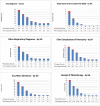'The influence of gestational age and socioeconomic status on neonatal outcomes in late preterm and early term gestation: a population based study'
- PMID: 22748037
- PMCID: PMC3464782
- DOI: 10.1186/1471-2393-12-62
'The influence of gestational age and socioeconomic status on neonatal outcomes in late preterm and early term gestation: a population based study'
Abstract
Background: Infants born late preterm (34 + 0 to 36 + 6 weeks GA (gestational age)) are known to have higher neonatal morbidity than term (37 + 0 to 41 + 6 weeks GA) infants. There is emerging evidence that these risks may not be homogenous within the term cohort and may be higher in early term (37 + 0 to 38 + 6 weeks GA). These risks may also be affected by socioeconomic status, a risk factor for preterm birth.
Methods: A retrospective population based cohort of infants born at 34 to 41 weeks of GA was assembled; individual and area-level income was used to develop three socioeconomic (SES) groups. Neonatal morbidity was grouped into respiratory distress syndrome (RDS), other respiratory disorders, other complications of prematurity, admission to a Level II/III nursery and receipt of phototherapy. Regression models were constructed to examine the relationship of GA and SES to neonatal morbidity while controlling for other perinatal variables.
Results: The cohort contained 25 312 infants of whom 6.1% (n = 1524) were born preterm and 32.4% (n = 8203) were of low SES. Using 39/40 weeks GA as the reference group there was a decrease in neonatal morbidity at each week of gestation. The odds ratios remained significantly higher at 37 weeks for RDS or other respiratory disorders, and at 38 weeks for all other outcomes. SES had an independent effect, increasing morbidity with odds ratios ranging from 1.2-1.5 for all outcomes except for the RDS group, where it was not significant.
Conclusions: The risks of morbidity fell throughout late preterm and early term gestation for both respiratory and non-respiratory morbidity. Low SES was associated with an independent increased risk. Recognition that the morbidities associated with prematurity continue into early term gestation and are further compounded by SES is important to develop strategies for improving care of early term infants, avoiding iatrogenic complications and prioritizing public health interventions.
Figures


Similar articles
-
Neonatal morbidity associated with late preterm and early term birth: the roles of gestational age and biological determinants of preterm birth.Int J Epidemiol. 2014 Jun;43(3):802-14. doi: 10.1093/ije/dyt251. Epub 2013 Dec 27. Int J Epidemiol. 2014. PMID: 24374829 Free PMC article.
-
Examining Early Childhood Health Outcomes of Children Born Late Preterm in Urban Manitoba.Matern Child Health J. 2017 Dec;21(12):2141-2148. doi: 10.1007/s10995-017-2329-5. Matern Child Health J. 2017. PMID: 28710699
-
Neonatal health of infants born to mothers with asthma.J Allergy Clin Immunol. 2014 Jan;133(1):85-90.e1-4. doi: 10.1016/j.jaci.2013.06.012. Epub 2013 Aug 3. J Allergy Clin Immunol. 2014. PMID: 23916153 Free PMC article.
-
Antenatal corticosteroids beyond 34 weeks gestation: What do we do now?Am J Obstet Gynecol. 2016 Oct;215(4):423-30. doi: 10.1016/j.ajog.2016.06.023. Epub 2016 Jun 21. Am J Obstet Gynecol. 2016. PMID: 27342043 Review.
-
Short-term outcomes of infants born at 35 and 36 weeks gestation: we need to ask more questions.Semin Perinatol. 2006 Feb;30(1):28-33. doi: 10.1053/j.semperi.2006.01.005. Semin Perinatol. 2006. PMID: 16549211 Review.
Cited by
-
MATERNAL AND FETAL RISK FACTORS ASSOCIATED WITH LATE PRETERM INFANTS.Rev Paul Pediatr. 2019 Nov 25;38:e2018136. doi: 10.1590/1984-0462/2020/38/2018136. eCollection 2020. Rev Paul Pediatr. 2019. PMID: 31778408 Free PMC article.
-
Prenatal exposure to tobacco smoke leads to increased mitochondrial DNA content in umbilical cord serum associated to reduced gestational age.Int J Environ Health Res. 2017 Feb;27(1):52-67. doi: 10.1080/09603123.2016.1268677. Int J Environ Health Res. 2017. PMID: 28002977 Free PMC article.
-
Childbirth-Related Hospital Burden by Socioeconomic Status in a Universal Health Care Setting.Int J Popul Data Sci. 2018 Jul 5;3(1):418. doi: 10.23889/ijpds.v3i1.418. Int J Popul Data Sci. 2018. PMID: 32935000 Free PMC article.
-
Association of Parental Socioeconomic Status and Newborn Telomere Length.JAMA Netw Open. 2020 May 1;3(5):e204057. doi: 10.1001/jamanetworkopen.2020.4057. JAMA Netw Open. 2020. PMID: 32364595 Free PMC article.
-
Mother-infant interaction improves with a developmental intervention for mother-preterm infant dyads.Infant Behav Dev. 2013 Dec;36(4):694-706. doi: 10.1016/j.infbeh.2013.07.004. Epub 2013 Aug 22. Infant Behav Dev. 2013. PMID: 23962543 Free PMC article. Clinical Trial.
References
-
- Raju TNK. The problem of late-preterm (near-term) births: a workshop summary. Pediatr Res. 2006;60:775–776. - PubMed
-
- Gilbert WM, Nesbitt TS, Danielsen B. The cost of prematurity: quantification by gestational age and birth weight. Obstet Gynecol. 2003;102:488–492. - PubMed
-
- Martens PJ, Derksen S, Gupta S. Predictors of hospital readmission of Manitoba newborns within six weeks postbirth discharge: a population-based study. Pediatrics. 2004;114:708–713. - PubMed
-
- Escobar GJ, Clark RH, Greene JD. Short-term outcomes of infants born at 35 and 36 weeks gestation: we need to ask more questions. Semin Perinatol. 2006;30:28–33. - PubMed
-
- Escobar GJ, Joffe S, Gardner MN, Armstrong MA, Folck BF, Carpenter DM. Rehospitalization in the first two weeks after discharge from the neonatal intensive care unit. Pediatrics. 1999;104:e2. - PubMed
MeSH terms
LinkOut - more resources
Full Text Sources
Molecular Biology Databases

